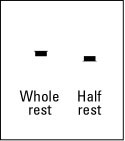During a rest, you should get your fingers and hands ready to play the next set of notes. Don't put your hands in your lap or your pockets. Keep them on the keys, ready to play whatever may follow.
For every note length, a corresponding rest exists. And, as you may guess, for every rest there is a corresponding symbol. Here they are for the taking.Whole and half rests: Hold on to your hat
When you see a whole note F, you play F and hold it for four beats. For a half note, you play and hold the note for two beats. A whole rest and half rest ask you to pause, not play anything, for the corresponding number of beats.Figure 1 shows both the whole and half rests. They look like little hats, one "on" and one "off." This hat analogy, and the rules of etiquette, make for a good way to remember these rests:
- If you rest for only half of the measure (two beats), the hat stays on.
- If you rest for the entire measure (four beats), take off your hat and stay for a while.



Quarter rests and more
Composers also use rests to tell you to stop playing for the equivalent of quarter notes, eighth notes, and sixteenth notes. Figure 4 shows you the musical squigglies that correspond to each of these resting periods.
Think of the quarter rest as an uncomfortable-looking chair. Because it's uncomfortable, you won't rest too long. In fact, you don't rest any longer than one beat in this chair.
The eighth rest and sixteenth rest are easy to recognize: They have the same number of "flags" — although slightly different in fashion — as their note counterparts. An eighth note and eighth rest each have one flag. Sixteenth notes and rests have two flags.Quarter rests are easy to count — they last only one beat. Eighth rests are a bit harder to count simply because they happen faster. When you play eighth rests, count out loud "1-and, 2-and," and so on. Doing so helps you place the eighth rests more precisely, and may even cause others to sing along.
Figure 5 gives you a chance to count out some quarter and eighth rests.







